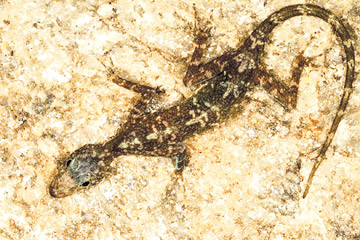|
Adding more variety to Sri Lanka's rich bio
diversity:
A new gecko species discovered
By Dhaneshi Yatawara
 |
|
Cnemaspis rammalensisí |
A recent discovery of a new rock-dwelling gecko species became
rocking news in the environment field. The new species found in a unique
habitat in the Rammalakanda Forest in the Hambantota district is
scientifically known as 'Cnemaspis rammalensis'. According to the
research team leader expert herpetologist Mendis Wickramasinghe, this
newly found gecko is the largest so far reported from its genus in Sri
Lanka and the second largest found in the Western Ghats ( India) - Sri
Lanka biodiversity region.
Sri Lanka and Western Ghats region in India are considered as
biodiversity hotspots. The new gecko is named as 'Rammale diva huna',
'Rammale pahalpalli' and 'Rammale day gecko' in Sinhala, Tamil and in
English.
Slender body
Geckos in the genus 'Cnemaspis' are characterised by a diminutive,
slender body, large forward and upwardly directed eyes with round
pupils, and elongate slender digits bent at an angle with entire
subdigital lamellae. These cryptically coloured geckos select specific
small areas as their habitats and come out during the day time.
As Wickramasinghe described this rock dwelling gecko is a cave and
crevice dweller, and can only be found within well-shaded caves, on rock
surfaces and inside rock crevices.
Forest patch
"It was found to inhabit only the primary rain forest in its type
locality and was not observed in the adjacent secondary forest or
well-wooded home gardens, and was not seen in association with trees,"
he said.
As researchers said, such a large species living in a small forest
patch at the edge of the wet zone was unexpected.
"The new species can easily be identified from the others by the
presence of a unique, prominent, black bar at the nape," Wickramasinghe
said.
The research team headed by Wickramasinghe includes Dulanga
Widanapathirana, Nethu Wickramasinghe of the Herpetological Foundation
of Sri Lanka and Gehan Rajeev of the Centre for Applied Biodiversity
Research and Education.
National Museum
'Cnemaspis' is a genus of diurnal geckos found in Asia. With around
75 species, it is one of the most diverse genera of geckos or even
lizards.
Specimens are deposited in the National Museum of Sri Lanka and the
Department of National Wildlife Research and Training Centre, Girithale.
The particular spot where this new gecko was discovered, the
Rammalakanda Forest Reserve is located in the border between Hambantota
and Matara districts which spreads over 1,700 hectares in extent, and
over 400 hectares of this had been declared as a Man and Biosphere
Reserve by the Forest Department.
Geographically the Reserve is situated in the southeast end of the
wet zone.
Rammalakanda is an elongated hill range approximately 10 km in length
and reaching about 700 metres. Rammalakanda has been recognised as one
of the 70 top priority forests in terms of watershed protection and the
faunal and floral diversity, by the National Conservation Review.
Tea plantations
"Today tea plantations and human settlements in the surrounding areas
are slowly expanding, and are encroaching towards the forest. It is
slowly destroying the habitat of this species," Wickramasinghe said.
Geckos are considered to be the most primitive living saurian in Sri
Lanka. According to research done in 1877 there have been a record
sixteen species of geckos and this is mentioned in the book 'Reptile
Fauna of Ceylon' by Ferguson.
This is supposed to be the first comprehensive and fully annotated
list of the Sri Lankan herpetofauna.
Subsequently leading researchers such as Deraniyagala and Taylor have
described 15 species in eight genera and 20 species in eight genera,
respectively.
Again in 1953, Deraniyagala increased the number of species and
subspecies to 19 in the volume II of the Colored atlas of vertebrates of
Ceylon.
In recent findings by researchers such as Manamendra-Arachchi it was
considered the Sri Lankan gecko wealth to be 19 living forms and after
several additions Anslem de Silva in 2006 lists 25 taxa (groups) in his
checklist.
With the description of several new 'Cnemaspis' species in 2007
before 'Cnemaspis rammalensis' the total number now has risen to 42,
according to herpetologists. |

